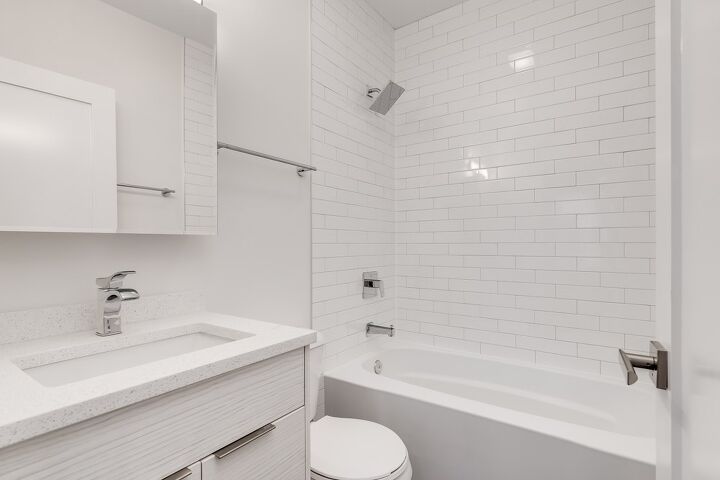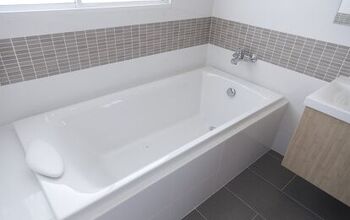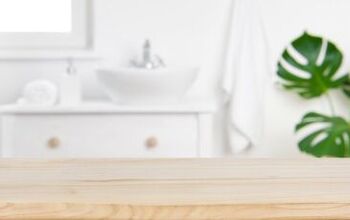Vikrell Vs. Acrylic Bathroom Fixtures: Which Is Better?

When planning your bathroom remodel, you must decide what type of shower, tub surround, and sink fits your needs best. Many homeowners narrow the choices down to two types, Vikrell or acrylic. To make the best choice, you must understand the differences between Vikrell and acrylic.
Acrylic and Vikrell are crafted materials that lend themselves very well to uses in bathrooms. These materials provide features such as hard surfaces that are easy to clean and inexpensive manufacturing costs. Vikrell is a blend of fiberglass and polyresin. Acrylic is vacuum-molded acrylic plastic sheets incorporating small amounts of fiberglass for reinforcement. Each material has its pros and cons.
There are some things to consider as you make your choice of bathroom fixtures. Each material has a slightly different set of advantages and disadvantages that you should weigh. Looking at each material’s properties, strengths, and weaknesses can give you better data on which to decide.
Do You Need to Hire a Plumber?
Get free, zero-commitment quotes from pro contractors near you.

| Vikrell | Acrylic | |
| Materials | Fiberglass and Polyresin | Acrylic, resin, and glass fibers |
| Durability | Exceptionally durable and strong | Durable finish with good strength |
| Ease of Maintenance | Easy to clean and maintain | It May be damaged by some cleaners |
| Installation Requirements | Requires a rigid base | Easy installation and lightweight |
| Colors Available | Only White | A wide variety of colors |
Vikrell – Kohler’s Entry into the Fixture Material Market
Vikrell is the brand name of a popular fiberglass product used to manufacture popular bathroom fixtures. The basic components of Vikrell are fiberglass resin, short glass fibers and plastic materials used for strength. A mold is covered with the Vikrell material to produce the required shapes.
The Advantages of Vikrell
Using Vikrell to make bathroom structures that meet water makes sense. Vikrell provides several features that make it an excellent material for shower enclosures, bathtubs, and other bathroom features.
- Vikrell is extremely durable and usually gives years of service without problems. The combination of fiberglass and polyresins produces a robust substructure that withstands daily use.
- The surface of Vikrell fixtures is hard enough to withstand daily use. This resistance to scratches is especially important in shower pans or bathtubs.
- Fixtures made of Vikrell tend to be much lighter than comparable fixtures of other materials. Lighter weight can be important when considering structural loads and the requirements for framing and special supports.
- Many molded bathroom fixtures come in pieces that require assembly. Watertightness is always an issue with fixtures that include multiple interlocking parts. Vikrell is an excellent material for forming seals and watertight joints.
- Cleaning any fiberglass surface is always a concern. Vikrell has a hard surface that can withstand most common household cleaners without worry. You should avoid extremely harsh chemical cleaners or anything that is highly abrasive.
Overall, Vikrell offers good structural strength for its weight. The surface of Vikrell is impervious to most common over-the-counter bathroom cleaners and will retain its lustrous finish for many years.
The Disadvantages of Vikrell
Two main issues haunt bathroom structures made from Vikrell. Most homeowners will be aware of one of these issues. However, the other is less well known but should be understood if you choose Vikrell fixtures.
- The most common downside of Vikrell is the color choices available. If white is your color of choice, you can be happy with Vikrell fixtures. Vikrell only comes in white, and that is a problem for some homeowners
- The lesser-known issue is the installation requirements for Vikrell plumbing fixtures. Vikrell needs a sound and rigid foundation to perform adequately over time. Experienced installers who work with Vikrell products regularly will understand the requirements. An improper foundation can lead to flexing and cracking of your Vikrell fixtures over time.
If you are happy with white fixtures and ensure that the installation is correct, Vikrell fixtures can provide many years of satisfactory service.
Acrylic – Not Just for Paint and Fabric
Almost everyone is familiar with acrylics. Artists use them to create wonderful visual effects. Painters depend on acrylic-based paint for both interior and exterior finishes. Acrylics give vibrant colors to our clothing. Acrylic is a plastic that has found uses across a wide range of products.
The Advantages of Acrylics
The use of acrylics to make plumbing fixtures and structures is a natural evolution for this product. Acrylic enjoys several features that make it ideal for bathroom fixtures and structures. These features are further enhanced when acrylic combines with other materials such as fiberglass. Features that make acrylic so attractive for use in bathrooms include:
- Acrylics produce a non-porous surface that resists water intrusion and the subsequent structural damage that can occur with fiberglass.
- The surface of acrylic bathroom fixtures resists mildew growth and other undesirable organisms that are frequent problems in high humidity areas such as bathrooms and laundry rooms.
- Installation of acrylic fixtures is typically easy and fast. The lightweight of these materials makes them easy to handle and move. In addition, there are very few special structural requirements for supporting acrylic bathroom structures.
- The insulating properties of acrylic fixtures make them desirable, especially for bathtubs. Bathtubs and water-jet tubs will hold the temperature of the water longer than tubs made of other materials.
- Acrylic bathroom fixtures are manufactured using a vacuum molding process that allows a wide range of flexibility in design. Some manufacturers will produce custom-fit designs for special order projects.
- Acrylics feature an almost unlimited color palette. You can order bathroom fixtures and structures in almost any color imaginable. This wide range of color availability is attractive to many homeowners who want a custom look.
If you want anything other than a white bathroom, acrylic bathroom fixtures are the alternative.
The Acrylic Disadvantages
Plastics such as acrylic are amazing products but do come with their own set of disadvantages. Understanding the shortcomings of acrylic bathroom fixtures is important to make a wise decision for your bathroom design.
- The surface of most acrylic bathroom fixtures is slightly less durable than Vikrell. The plastic acrylic surface is easier to scratch and somewhat more inclined to damage. Cleaning and maintaining an acrylic fixture or structure means being more selective in your choice of cleaning products. Most manufacturers of acrylic bathroom fixtures and structures recommend the use of non-abrasive cleaning products.
- Acrylic bathroom fixtures cost more than Vikrell fixtures overall. Part of the cost difference is the manufacturing techniques involved and the cost of base materials. The actual final costs difference may not be much, but the difference could affect your bathroom costs enough to be a consideration.
Durability doesn’t become an issue in most homes under normal residential single-family use. However, if you anticipate high traffic or unusual cleaning demands, acrylic’s softer surface may not be a wise choice.
The Head to Head Comparison
This chart makes it easier to see the differences and similarities in acrylic and Vikrell bathroom fixtures. There is no clear-cut definitive choice. Each material has its unique qualities, advantages, and disadvantages. You must consider your situation and find the best fit for your needs.
| Vikrell | Acrylic | |
| Cost | Slightly cheaper overall | Slightly More Expensive |
| Durability | Slightly harder surface finish and more resistant to chemicals | It offers a more luxurious finish but is softer and more easily scratched especially be abrasive cleaners |
| Strength | More rigid structure but requires a more substantial foundation in most cases | It has a more forgiving structure that can adapt to small imperfections in the supporting foundations |
| Method of Manufacture | Typically formed on molds by spraying the Vikrell material | Acrylic products are vacuum formed on industrial molds |
| Materials used in the Construction | Fiberglass with polyresin materials added | Acrylic plastic sheets, fiberglass, and resin for strength |
| Colors | Only White | A rainbow of color options is available |
| Cost | A bit less expensive | Usually more expensive |
Which is Better?
Deciding which is the better product is a matter of balancing the pros and cons of each with the expected uses of the bathroom fixture. You must be the judge of which product best fits your needs and expectations. We can offer this advice about each product.
- High-traffic areas will usually do better with a Vikrell product. The harder surface and more rigid structure wear better under high volumes of use.
- Designer bathrooms typically call for acrylic fixtures. Acrylic fixtures offer more color choices and usually a broader range of design features.
- Commercial installations should shy away from acrylic. These kinds of installations usually require more abrasive and caustic cleaning agents than a residential installation, and acrylic may not respond well to these types of cleaning agents.
- Acrylic bathroom fixtures and structures often offer more style choices and are slightly easier to fit and install into existing bathrooms.
How and where the bathroom fixtures are located and used is the biggest factor in choosing between acrylic and Vikrell. You should carefully consider the advantages and disadvantages of both products balanced against your project and its expected uses.
Do You Need to Hire a Plumber?
Get free, zero-commitment quotes from pro contractors near you.

Vikrell or Acrylic?
Both Vikrell and acrylic have a place when choosing bathroom fixtures and structures. There is no clear-cut winner. Some installations make Vikrell a better fit. Other considerations may swing the balance toward acrylic. Vikrell and acrylic enjoy proven track records for these uses when properly installed and under the proper uses.

Dennis is a retired firefighter with an extensive background in construction, home improvement, and remodeling. He worked in the trades part-time while serving as an active firefighter. On his retirement, he started a remodeling and home repair business, which he ran for several years.
More by Dennis Howard



















![12 Washing Machine Brands to Avoid [with Recall Data]](https://cdn-fastly.upgradedhome.com/media/2023/07/31/9075781/12-washing-machine-brands-to-avoid-with-recall-data.jpg?size=350x220)






